刘禹锡陋室铭英文翻译及详细解析
【2018最新】陋室铭英文翻译及赏析word版本 (4页)

本文部分内容来自网络整理,本司不为其真实性负责,如有异议或侵权请及时联系,本司将立即删除!== 本文为word格式,下载后可方便编辑和修改! ==陋室铭英文翻译及赏析陋室铭》是这首铭文作为经典流传至今,不仅因其思想内容积极乐观,境界高远,其语言上的特色上的独特魅力也是不容忽视的。
下面由小编为大家精心收集的陋室铭英文翻译及赏析,希望可以帮到大家!山不在高,有仙则名。
水不在深,有龙则灵。
斯是陋室,惟吾德馨。
苔痕上阶绿,草色入帘青。
谈笑有鸿儒,往来无白丁。
可以调素琴,阅金经。
无丝竹之乱耳,无案牍之劳形。
南阳诸葛庐,西蜀子云亭。
孔子云:“何陋之有?”注释⑴ 在:在于,动词。
⑵ 名:出名,著名,因--而著名,名词作动词。
⑶ 灵:显得有灵气,名词作动词。
⑷ 斯是陋室:这是简陋的屋子。
斯:此,这。
是:表判断。
陋室:简陋的屋子。
⑸ 惟吾德馨:只是我(住屋的人)的品德高尚(就不感到简陋了)惟:只。
吾:我,这里指住屋的人自己。
馨:香气,这里指品德高尚。
(6)上:动词,长到,蔓到。
⑺ 鸿儒:即大学问家,这里指博学而又品德高尚的人。
鸿:大。
儒:旧指读书人。
⑻ 白丁:平民,这里指没有什么学问的人。
⑼调素琴:弹奏不加装饰的琴。
调:调弄,这里指弹(琴)。
素琴:不加装饰的古琴。
⑽金经:指用泥金书写的佛经。
即《金刚经》。
⑾丝竹:指琴瑟、箫管等乐器,这里指奏乐的声音。
“丝”指弦乐器,“竹”指管乐器。
这里指音乐。
⑿之:助词,不译。
用在主谓间,取消句子的独立性。
⒀乱耳:扰乱双耳。
乱:形容词的使动用法,使……乱,扰乱。
⒁案牍(dú):官府的公文。
⒂劳形:使身体劳累(使动用法)。
劳:形容词的使动用法,使……劳累。
形:形体、身体。
⒃南阳:地名,今河南省南阳市西。
诸葛亮在出山之前,曾在南阳卧龙岗中隐居躬耕。
⒄南阳诸葛庐,西蜀子云亭:南阳有诸葛亮的草庐,西蜀有扬子云的亭子。
这两句是说,诸葛庐和子云亭都很简陋,因为居住的人很有名,所以受到人们的景仰。
【参考文档】陋室铭英文翻译及赏析-范文模板 (4页)
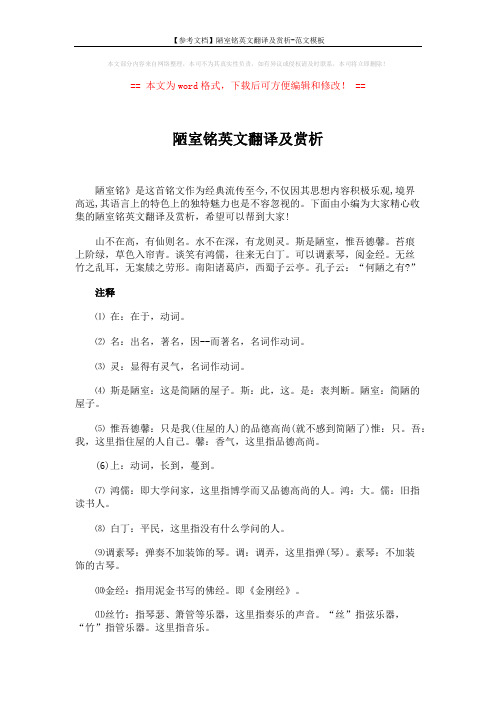
本文部分内容来自网络整理,本司不为其真实性负责,如有异议或侵权请及时联系,本司将立即删除!== 本文为word格式,下载后可方便编辑和修改! ==陋室铭英文翻译及赏析陋室铭》是这首铭文作为经典流传至今,不仅因其思想内容积极乐观,境界高远,其语言上的特色上的独特魅力也是不容忽视的。
下面由小编为大家精心收集的陋室铭英文翻译及赏析,希望可以帮到大家!山不在高,有仙则名。
水不在深,有龙则灵。
斯是陋室,惟吾德馨。
苔痕上阶绿,草色入帘青。
谈笑有鸿儒,往来无白丁。
可以调素琴,阅金经。
无丝竹之乱耳,无案牍之劳形。
南阳诸葛庐,西蜀子云亭。
孔子云:“何陋之有?”注释⑴ 在:在于,动词。
⑵ 名:出名,著名,因--而著名,名词作动词。
⑶ 灵:显得有灵气,名词作动词。
⑷ 斯是陋室:这是简陋的屋子。
斯:此,这。
是:表判断。
陋室:简陋的屋子。
⑸ 惟吾德馨:只是我(住屋的人)的品德高尚(就不感到简陋了)惟:只。
吾:我,这里指住屋的人自己。
馨:香气,这里指品德高尚。
(6)上:动词,长到,蔓到。
⑺ 鸿儒:即大学问家,这里指博学而又品德高尚的人。
鸿:大。
儒:旧指读书人。
⑻ 白丁:平民,这里指没有什么学问的人。
⑼调素琴:弹奏不加装饰的琴。
调:调弄,这里指弹(琴)。
素琴:不加装饰的古琴。
⑽金经:指用泥金书写的佛经。
即《金刚经》。
⑾丝竹:指琴瑟、箫管等乐器,这里指奏乐的声音。
“丝”指弦乐器,“竹”指管乐器。
这里指音乐。
⑿之:助词,不译。
用在主谓间,取消句子的独立性。
⒀乱耳:扰乱双耳。
乱:形容词的使动用法,使……乱,扰乱。
⒁案牍(dú):官府的公文。
⒂劳形:使身体劳累(使动用法)。
劳:形容词的使动用法,使……劳累。
形:形体、身体。
⒃南阳:地名,今河南省南阳市西。
诸葛亮在出山之前,曾在南阳卧龙岗中隐居躬耕。
⒄南阳诸葛庐,西蜀子云亭:南阳有诸葛亮的草庐,西蜀有扬子云的亭子。
这两句是说,诸葛庐和子云亭都很简陋,因为居住的人很有名,所以受到人们的景仰。
《陋室铭》中英文对照
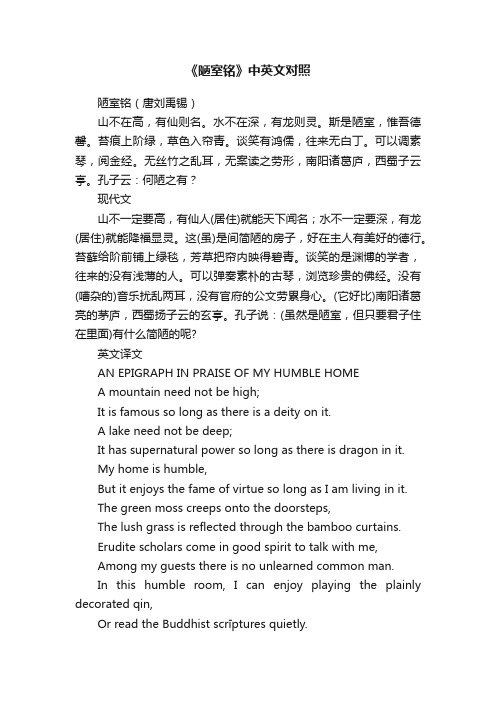
《陋室铭》中英文对照陋室铭(唐刘禹锡)山不在高,有仙则名。
水不在深,有龙则灵。
斯是陋室,惟吾德馨。
苔痕上阶绿,草色入帘青。
谈笑有鸿儒,往来无白丁。
可以调素琴,阅金经。
无丝竹之乱耳,无案读之劳形,南阳诸葛庐,西蜀子云亭。
孔子云:何陋之有?现代文山不一定要高,有仙人(居住)就能天下闻名;水不一定要深,有龙(居住)就能降福显灵。
这(虽)是间简陋的房子,好在主人有美好的德行。
苔藓给阶前铺上绿毯,芳草把帘内映得碧青。
谈笑的是渊博的学者,往来的没有浅薄的人。
可以弹奏素朴的古琴,浏览珍贵的佛经。
没有(嘈杂的)音乐扰乱两耳,没有官府的公文劳累身心。
(它好比)南阳诸葛亮的茅庐,西蜀扬子云的玄亭。
孔子说:(虽然是陋室,但只要君子住在里面)有什么简陋的呢?英文译文AN EPIGRAPH IN PRAISE OF MY HUMBLE HOMEA mountain need not be high;It is famous so long as there is a deity on it.A lake need not be deep;It has supernatural power so long as there is dragon in it.My home is humble,But it enjoys the fame of virtue so long as I am living in it.The green moss creeps onto the doorsteps,The lush grass is reflected through the bamboo curtains.Erudite scholars come in good spirit to talk with me,Among my guests there is no unlearned common man.In this humble room, I can enjoy playing the plainly decorated qin,Or read the Buddhist scrīptures quietly.Without the disturbance of the noisy tunes that jar on the ears;Or the solemn burden of official documents.My humble house is just like the thatched hut of Zhuge Liang of NanYangOr the Pavilion ZiYun of XiShuCon fusius once said, “how could we call a room humble so long sa there is virtuous man in it”。
陋室铭之英文翻译

Inscription of My Shack①A hill can get a great fame with an immortal living in it, despite of its height; a lake can gain a good reputation with a dragon lurking in it, despite of its depth. ②Although it is just a shack, one would not be aware of its simplicity because of my noble character. ③Green moss grows onto my stone steps, the verdant color of grass leaps into my door. ④All of the men chatting and laughing here are of wide erudition, none of the men contacting with me are of little learning. ⑤In my shack, I can play my undecorated Guqin (a seven-stringed plucked instrument), I can also read my treasured books. ⑥No mundane music would disturb my ears; no official documents would exhaust me (my body). ⑦This shack is similar to both Zhuge Liang’s thatched cottage in Nan Yan and Yang Ziyun’s pavilion in Xi Shu. ⑧Just like what Confucius said, ‘with a gentlemen living in it, how can one call it simple?’在做这篇翻译的时候,我用到的句子都比较对称,因为我注意到原文的句子有对称的特点。
陋室铭全文解释及译文
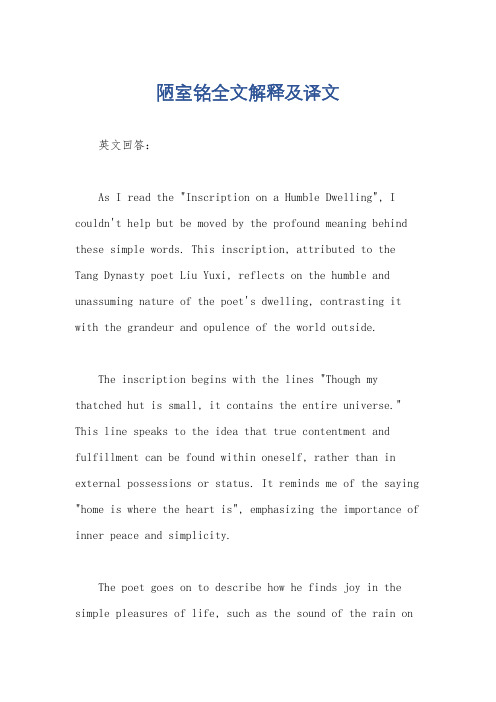
陋室铭全文解释及译文英文回答:As I read the "Inscription on a Humble Dwelling", I couldn't help but be moved by the profound meaning behind these simple words. This inscription, attributed to the Tang Dynasty poet Liu Yuxi, reflects on the humble and unassuming nature of the poet's dwelling, contrasting it with the grandeur and opulence of the world outside.The inscription begins with the lines "Though my thatched hut is small, it contains the entire universe." This line speaks to the idea that true contentment and fulfillment can be found within oneself, rather than in external possessions or status. It reminds me of the saying "home is where the heart is", emphasizing the importance of inner peace and simplicity.The poet goes on to describe how he finds joy in the simple pleasures of life, such as the sound of the rain onhis roof or the view of the mountains in the distance. He finds beauty in the mundane and the everyday, showing that one does not need extravagant luxuries to find happiness.One of my favorite lines in the inscription is "I mend my clothes among the remnants of the clouds." This image of the poet sewing his clothes amidst the clouds evokes asense of harmony with nature and a connection to the world around him. It reminds me of the importance of beingmindful and present in the moment, finding beauty in the small details of life.Overall, the "Inscription on a Humble Dwelling" is a powerful reminder of the value of simplicity, humility, and gratitude. It encourages us to appreciate the beauty in the ordinary and to find contentment within ourselves, rather than in external wealth or status.中文回答:读完“陋室铭”,我深受这些简单文字背后的深刻含义所感动。
刘禹锡陋室铭英文翻译及详细解析
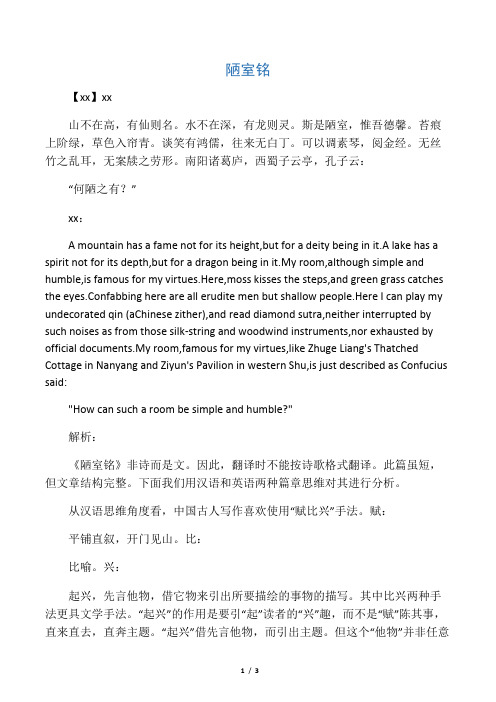
陋室铭【xx】xx山不在高,有仙则名。
水不在深,有龙则灵。
斯是陋室,惟吾德馨。
苔痕上阶绿,草色入帘青。
谈笑有鸿儒,往来无白丁。
可以调素琴,阅金经。
无丝竹之乱耳,无案牍之劳形。
南阳诸葛庐,西蜀子云亭,孔子云:“何陋之有?”xx:A mountain has a fame not for its height,but for a deity being in it.A lake has a spirit not for its depth,but for a dragon being in it.My room,although simple and humble,is famous for my virtues.Here,moss kisses the steps,and green grass catches the eyes.Confabbing here are all erudite men but shallow people.Here I can play my undecorated qin (aChinese zither),and read diamond sutra,neither interrupted by such noises as from those silk-string and woodwind instruments,nor exhausted by official documents.My room,famous for my virtues,like Zhuge Liang's Thatched Cottage in Nanyang and Ziyun's Pavilion in western Shu,is just described as Confucius said:"How can such a room be simple and humble?"解析:《陋室铭》非诗而是文。
《陋室铭》英文翻译及赏析

《陋室铭》英文翻译及赏析陋室铭朝代:唐代作者:刘禹锡原文:山不在高,有仙则名。
水不在深,有龙则灵。
斯是陋室,惟吾德馨。
苔痕上阶绿,草色入帘青。
谈笑有鸿儒,往来无白丁。
可以调素琴,阅金经。
无丝竹之乱耳,无案牍之劳形。
南阳诸葛庐,西蜀子云亭。
孔子云:何陋之有?《陋室铭》英文翻译An Eulogium on a Humble CellLiu YuxiA mount needs not be high; it becomes noted when on it fairies dwell.A body of water needs not be deep; it would be ensouled, if a dragon makes it its resting whereabouts.This hut of mine is a humble one, but I make it virtuously fragrantin repute.The green moss creeping on the stepping stones and the verdure inthe courtyard peeing through the screen do tell the presence of spring.Here could be heard the table-talks and laughters of renowned scholars, but the rough and gross come not hither their wares to sell.Here plain table-heptachord could be plucked and golden classicsread the worldly cares to quell.But there are without riotous strings and pipes to confuse the ears, and tedious official documents to ring quietude’s knell.Zhuge’s recluse cottage at Nanyang and Yang Xiong’s hermit arbo ur in West Shu, –according to Confucius, wherefore could either one of them be branded as a humble cell?《陋室铭》译文《陋室铭》注释⑴陋室:简陋的屋子。
刘禹锡《陋室铭》原文及翻译
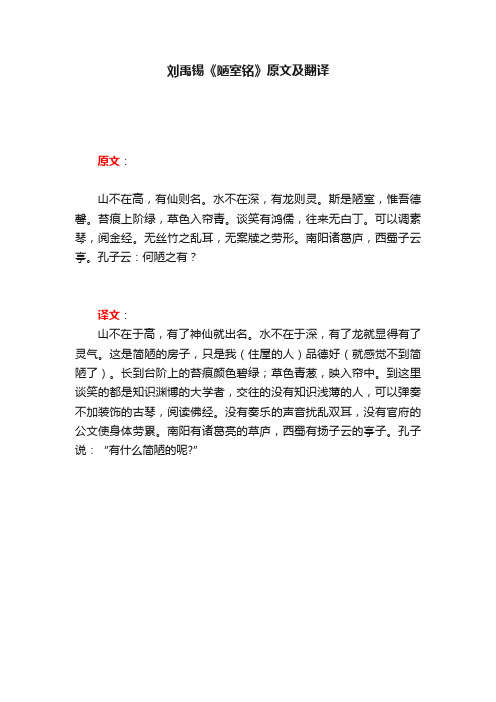
刘禹锡《陋室铭》原文及翻译
原文:
山不在高,有仙则名。
水不在深,有龙则灵。
斯是陋室,惟吾德馨。
苔痕上阶绿,草色入帘青。
谈笑有鸿儒,往来无白丁。
可以调素琴,阅金经。
无丝竹之乱耳,无案牍之劳形。
南阳诸葛庐,西蜀子云亭。
孔子云:何陋之有?
译文:
山不在于高,有了神仙就出名。
水不在于深,有了龙就显得有了灵气。
这是简陋的房子,只是我(住屋的人)品德好(就感觉不到简陋了)。
长到台阶上的苔痕颜色碧绿;草色青葱,映入帘中。
到这里谈笑的都是知识渊博的大学者,交往的没有知识浅薄的人,可以弹奏不加装饰的古琴,阅读佛经。
没有奏乐的声音扰乱双耳,没有官府的公文使身体劳累。
南阳有诸葛亮的草庐,西蜀有扬子云的亭子。
孔子说:“有什么简陋的呢?”。
- 1、下载文档前请自行甄别文档内容的完整性,平台不提供额外的编辑、内容补充、找答案等附加服务。
- 2、"仅部分预览"的文档,不可在线预览部分如存在完整性等问题,可反馈申请退款(可完整预览的文档不适用该条件!)。
- 3、如文档侵犯您的权益,请联系客服反馈,我们会尽快为您处理(人工客服工作时间:9:00-18:30)。
陋室铭
【唐】刘禹锡
山不在高,有仙则名。
水不在深,有龙则灵。
斯是陋室,惟吾德馨。
苔痕上阶绿,草色入帘青。
谈笑有鸿儒,往来无白丁。
可以调素琴,阅金经。
无丝竹之乱耳,无案牍之劳形。
南阳诸葛庐,西蜀子云亭,孔子云:“何陋之有?”
英译:
A mountain has a fame not for its height, but for a deity being in it. A lake has a spirit not for it
s depth, but for a dragon being in it. My room, although simple and humble, is famous for my vir tues. Here, moss kisses the steps, and green grass catches the eyes. Confabbing here are all eru dite men but shallow people. Here I can play my undecorated qin (a Chinese zither), and read dia mond sutra, neither interrupted by such noises as from those silk-string and woodwind instrument s, nor exhausted by official documents. My room, famous for my virtues, like Zhuge Liang's Thatc hed Cottage in Nanyang and Ziyun's Pavilion in western Shu, is just described as Confucius said:" How can such a room be simple and humble?"
解析:
《陋室铭》非诗而是文。
因此,翻译时不能按诗歌格式翻译。
此篇虽短,但文章结构完整。
下面我们用汉语和英语两种篇章思维对其进行分析。
从汉语思维角度看,中国古人写作喜欢使用“赋比兴”手法。
赋:平铺直叙,开门见山。
比:比喻。
兴:起兴,先言他物,借它物来引出所要描绘的事物的描写。
其中比兴两种手法更具文学手法。
“起兴”的作用是要引“起”读者的“兴”趣,而不是“赋”陈其事,直来直去,直奔主题。
“起兴”借先言他物,而引出主题。
但这个“他物”并非任意任何“他物”,必须与主题有关,这样才能自然引入到主题上。
《陋室铭》中1-2句以“兴”起句“山不在高,有仙则名。
水不在深,有龙则灵。
”第3句为主题,如果按1-2句式,本应该写为:“室不在(仑)奂,有德则馨”。
但作者在句式上改为“斯是陋室,惟吾德馨”。
为什么要这么改动句式呢?很简单,如果不改而仍用前面相同的句式,就会让读者一直“兴”下去,从而感到疲惫,找不到主题。
这个主题中,“陋室”和“德馨”为中心;“陋室”为次,“德馨”为重。
次则笔墨不应多,重则应大事渲染。
作者只用第四句论述“陋室”;而用了三句从三个方面大事渲染“德馨”:第五句从人际交往论述自己的德馨、第六句从自身修养论述自己的德馨、第七句从世事工作论述
自己的“德馨”。
最后,第八句通过“比”的手法,引用圣人孔子的话“何陋之有?”回到主题上“室不在(仑)奂,有德则馨。
”
从英文思维角度看,英文essay篇章结构可分为宏结构(Macro-structure)和微结构(mirco-structure)。
宏结构可分为三个部分:introduction,body和conclusion。
“Introduction”顾名思义就是要“introducing”,其主要作用是: 1) introducing the background of the main idea(引入主题的背景),其中包括opening sentences。
2)introducing the reader to the main idea or theme (把读者引到主题上)。
“Body”主要围绕theme从加以论述。
“Conclusion”是对主题进行升华,而不是简单的重复。
《陋室铭》的宏结构第1-3句为introduction, 其中第1-2句为opening sentence,第3句为主题句。
第1-7句为Body部分。
第8句为Conclusion
微结构主要指句子组句成篇是所使用的手段。
手段有两种。
一是连贯(Coherence);一是衔接(Cohesion)。
Coherence: the relationships which link the meanings of utterances in a discourse or of the sentences in a text(Longman Dictionary of Applied Linguistics 1985:45)。
简单地说就是指句子与句子在意义上的一致性和贯通性。
Cohesion:the grammatical and / or lexical relationships between the different elements of a text. This may be the relationship between different sentences or between different parts of a sentence(Longman Dictionary of Applied Linguistics 45)。
简单地说,就是组句成篇时,各个句子或语言单位之间连接在一起时所使用的语言手段。
这种语言手段Halliday总结了四种:reference, ellipsis, conjunction and lexical organization (Halliday:2000:309)。
在连贯上,《陋室铭》各句子都是围绕“室不在奂,有德则馨”。
在衔接上,英语和汉语出现了较大差异。
英语是形合的语言,汉语是意和语言。
形合体现在衔接手段上,意合体现在连贯上。
因此,汉译英时,要充分利用英语的衔接手段使各个英文句子紧密衔接。
汉译英时,除了要注意英语衔接手段,也要考虑各个句子之间的主述位结构的分布。
《陋室铭》围绕“陋室”这个“主位”展开论述。
第1-2句为对仗句,主述位不同,而第3-8句的主位都是“陋室”,但汉语中在第4-8句中都未出现“陋室”,这就是一种意合方式。
翻译成英语时,要考虑第3-8句各句的主位保持一直。
第
3句以“my room”为主位,第4,5,6,7句根据Halliday提出的reference衔接手段,用“Here”提前,前指“my room”。
第8句,重复主位“My room”。
